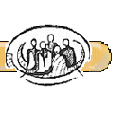Here are some research topics that we don't have answers for, and we hope you will find interesting.
When you are going about your research, keep in mind to approach it from a present day perspective - the values that we have today are not the values that were held in Emily Carr's day (i.e. early 20th Century). A good rule of thumb is to let the time or work speak for itself, regardless of the prejudice, ignorance, or controversy it may contain.
- Many people have strong reaction to Emily Carr's art. Here are the thoughts of some people who study Emily's work. After looking at the work yourself, please tell us which work you prefer, and why. Favourite Emily Carr work.
- Emily and her attitude towards children. Look through her books for references to children. Perhaps compile a few quotations to read to your classmates. Have the class discuss what her comments reveal about her attitudes.
- Emily and her relationship with her father.
We know that Emily's relationship with her father was a good one when she was young, but changed into a poor relationship when she got older. Why did this happen, and what factors contributed to this change? Begin with Emily's books before going to books about Emily (biographies, etc.). - Emily's attitude about women's work and her role as a Canadian feminist model.
Emily always maintained a very positive attitude towards women painters, and abhorred the Victorian notion of women's painting as a social skill rather than art. This topic has never really been adequately addressed.
Recently we have learned that in her will, Emily left paintings to all her nieces, but none of her nephews. This could be relevant, but it may not be -- maybe she just didn't like the nephews. - Was Emily Carr a feminist model and why or why not?
What were her views on housework and marriage, or painting as a career? - Emily's painting "lull" between 1912 and 1918.
Authorities on Emily's work - Art Historians - state that she stopped painting altogether between these two dates. Later research suggests that she did paint, but to a much lesser degree than she was known for. What was the reason for this lull, or what factors contributed to it?
Take a good look at the differences in her paintings before 1912 and after 1928. Do any major differences strike you? - What is the history of Emily Carr's mother?
Emily's mother, also named Emily, was an illegitimate child. Her maiden name was Saunders. Little is known about this side of the Carr family history, and the Carr family had very little contact with them. Who were they? - What would Emily have created or accomplished if she would have been supported financially and appreciated in her time?
- How was Emily's art influenced by the First Nations People of British Columbia?
Do you think that living with, and becoming friends with the people of those regions gives her paintings more feeling and meaning, or are they just documentary? What caused her to go and paint native images in the first place? - Emily's paintings with native imagery were first collected as archival records of First Nations villages and lives. It was assumed that the paintings were accurate. Are they accurate records of First Nations' history from that time period?
- Is it appropriate or acceptable for a non-First Nations person to represent First Nations people and their lives in art?
Is it only acceptable for an artist to portray what they themselves have directly experienced? (Art being visual, performing, or written forms) If so, did Emily directly experience what she painted? - Carr House is a typical Victorian house. Visit a similar house in your area to research its architecture. Take notes on the interior finishes; wallpapers, floor coverings, paint colours, fireplace finishes, door finishes, types of windows, etc. Compare those with the finishes in Carr House.
Research the restoration of the house (maybe interviewing the staff or curator and ask about research reports). Get a copy of Andrew Jackson Downing, or Louden's books on mid-19th Century architecture for information on the architectural and design ideals of the Victorian period.
Write a report, design a Victorian room or house, build a Victorian house model. - Emily Carr of Carr House and Kathleen O'Reilly of Point Ellice House (see Schoolnet site for Point Ellice House) were contemporaries. The women knew each other, although we have no documentation of their being friends or even acquaintances in early Victoria. Both women learned to paint. Compare their early art. Note their subject matter, colour palette, brush strokes, etc. Discuss in class. Try painting a still life.
Return to Index page.






